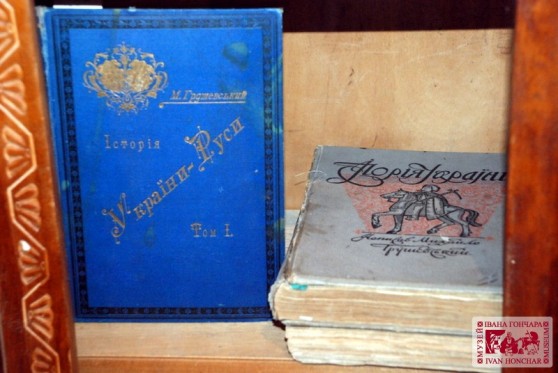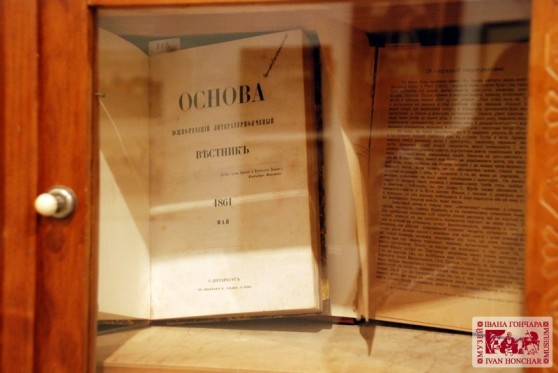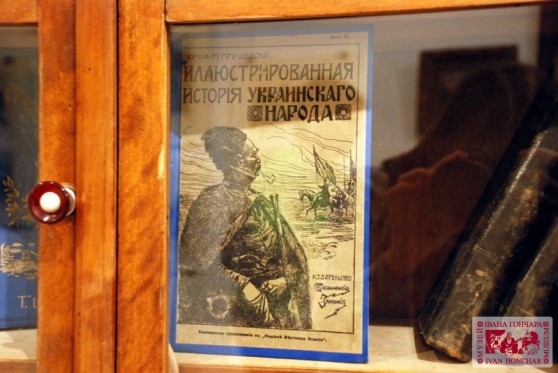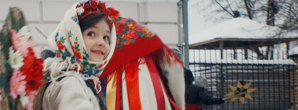-
 About & contacts
About & contacts
-
 Events
Events
-
 Web-project “Ukrainian culture”
Web-project “Ukrainian culture”
-
 Museum’s mission statement
Museum’s mission statement
-
 Exposition
Exposition
-
 Collection
Collection
-
 Ivan Honchar’s library
Ivan Honchar’s library
-
 Typical Ukrainians in the paintings of Ivan Honchar
Typical Ukrainians in the paintings of Ivan Honchar
-
 Ivan Honchar’s picturesque Ukraine
Ivan Honchar’s picturesque Ukraine
-
 Oasis of Ukrainian culture — Ivan Honchar Museum
Oasis of Ukrainian culture — Ivan Honchar Museum
-
 From the Guest book (1962-1988)
From the Guest book (1962-1988)
Ivan Honchar’s library was the academic and philosophic basis of his collections. When he began the search for items for his future museum in 1957, Ivan Honchar paid particular attention to the collecting of Ukrainian books. “I never lost sight of the search for antiquarian books on Ukrainica,” he emphasized.
Not willing to accept the falsification of the history of the Ukrainian people, Ivan Honchar collected books which would objectively testify about the place and role of Ukraine, her scholarship and culture. The carefully acquired books were not dead baggage for the collector. Despite the lack of time, Honchar constantly studied the literature, immersing himself in the historic and cultural past of our nation. This broadened the world view of the artist himself, formed a scientific base for later work, and inspired him to new journeys: “I read my newly-acquired Ukrainian-themed books, and they called me on a journey.”
Today, the memorial library of the museum holds approximately 3,000 volumes. Among these are rare manuscripts and early printed books from the 17-19th c., unique pre-revolutionary publications on Ukrainian history and ethnography – a notable spectrum of Ukrainian literature which, in Soviet times, was either silenced or defamed and hidden from use.
The cornerstone of the library was the miraculously preserved, by V. Kaminskyi, portion of the library of Mykola Arkas, the well-known Ukrainian historian, ethnographer, and composer. It somehow came into Ivan Honchar’s collection in 1959. Its core are the unique works of prominent Ukrainian historians, ethnographers and writers, published during their lifetimes: D. Bantysh-Kamens’kyi, M. Kostomarov, M. Maksymovych, V. Antonovych, M. Drahomanov, D. Yavornyts’kyi, P. Kulish, M. Markevych, O. Lazarevs’kyi, O. YEfymenko, M. Hrushevs’kyi, and others. Among the rare editions in the library, we must note the posthumous edition of Istoriia Ukrainy-Rusy [The History of Ukraine-Rus] by M. Arkas, published by his widow in Krakow in 1912. Also, among the rarities, is L. Pokhylevych’s Skazania o naselennykh miestnostiakh Kievskoi gubernii [Stories about the populated settlements of the Kyiv Province], Kyiv, 1864. This book has been a bibliographic treasure for a long time, for any researcher into the history of his or her homeland. Even by today’s standards, in its breadth and depth of material, this fundamental study into the Ukrainian way of life has no equal.
Ukrainian periodicals of the turn of the last century are well represented. A few of the many important titles are: Kievskaya starina (1882-1906), Osnova (1861-62), Ukrainskaya zhizn’ (1912-15), Literaturno-naukovyi visnyk (1899-1919), Zapysky NTSh (1897, 1901, 1906), Ukraina (1917-29), and many others. These titles truly reflected historical events in our land, revealing the atmosphere of these trying and complicated times for Ukraine. For example, published in these journals is the first mention of the death of Lesia Ukrainka, the announcement about the collection of funds for a monument to Taras Shevchenko being built by the clergy of the Chernihiv gubernia, reminiscences by S. Yefremov about his last meetings with B. Hrinchenko, the announcement of the renaming of the village of Mazepyntsi into Romanivs’ke…
The library also holds rare serials published in Western Ukraine before 1939 which, after the “reunification” of Ukrainian lands [under Soviet rule] were slated for destruction – Nova Khata (Lviv, 1932), art magazine Karby (Lviv, 1933), the children’s newspaper Dzvinochok (Lviv, 1934), Slavic philology journal Slovo (Lviv, 1936) and others.
Many publishing houses active during the 1920-30s in Ukraine are widely represented in this library: DVU, Chas, Dzvin, Knyhospilka, Rukh, NTSh, Prosvita, Krynytsia, and others. The geographic expanse of the publishing world in Ukraine is reflected in the cities represented: Kyiv, Lviv, Kharkiv, Myrhorod, Odesa, Cherkasy, Chernihiv, Mykolayiv, Poltava, Halych… This is far from a complete list of those publishing Ukrainian materials.
Scholarly works on the separate ethnic identity of Ukrainians are represented in the library, and also cover the geography, natural resources and wealth of Ukraine – books by S. Rudnytskyi, I. Teslia, and S. Rusova. Especially noteworthy is the two-volume Ukrainskii narod v ego proshlom I nastoyashchem [The Ukrainian people in their past and present], edited by F. Volkov [KHvedir Vovk], M. Hrushevskyi, A. Krymskyi, M. Kovalevskyi, F. Korsh, O. Shakhmatov, M. Tuhan-Baranovsky, published in S.-Peterburg, 1914-16.
It was no coincidence that publisher “Mystetstvo” collaborated with Ivan Honchar on the reprint of the now well-known work by Khvedir Vovk Studiyi z ukrains’koi etnohrafiyi ta antropolohiyi [Studies in Ukrainian ethnography and anthropology], Praha, 1928. Certainly, Honchar was the inspiration for the reprinting of this work, the basis of which was the original book preserved in his collection.
But primarily, Ivan Honchar was an artist whose soul sensed every nuance of the unparalleled beauty of Ukrainian folk art. That is why very dear to him were the art books in his collection, such as K. Dalmatov’s Uzory starodavnikh ukrainskikh vyshivok [Old Ukrainian embroidery designs], S.-Peterburg, S. Kulzhynskyi’s Opisanie kollektsiyi narodnykh pisanok [Description of the collection of folk pysanky], Moskva, 1899, M. Holubets’ Ukrains’ke mystetstvo: vstup do istoriyi [Ukrainian art: an introduction to the history], Kyiv-Lviv, 1918, H. Pavlutskyi’s Istoriya ukrains’koho ornamentu [History of Ukrainian ornament], Kyiv 1927, YE. Spas’ka’s Honcharni kakhli Chernihivshchyny: XVIII-XIX st. [Clay tiles of the Chernihiv region, 18-19th c.], Kyiv, 1928, and others.
In his memoirs, Ivan Honchar remembered with anguish his travels across Ukraine, as he witnessed the destruction of Ukrainian national treasures. Through his diligent and urgent work in collecting precious examples of Ukrainian religious architecture, he became familiar with the works of the following scholars: V. Sherbakivskyi’s Derevliani tserkvy na Ukraini i yikh typy [Wooden churches in Ukraine and their styles], Lviv 1906, and Arkhitektura u rizhnykh narodiv i na Ukraini [Architecture among various peoples and in Ukraine] Lviv-Kyiv, 1910; M. Shumyts’ky’s Ukrains’kyi arkhitekturnyi styl’ [The Ukrainian architectural style], Kyiv, 1914; M. Drahan’s Ukrains’ki derevliani tserkvy: heneza i rozviy formy [Ukrainian wooden churches: their genesis and development of form], Lviv, 1937; P. Yurchenko’s Derev’iana arkhitektura Ukrainy [Wooden architecture of Ukraine], Kyiv 1970; S. Taranushchenko’s Pam’iatky derev’ianoyi architektury Livoberezhnoyi Ukrainy [Monuments of wooden architecture of Left-bank Ukraine] Kyiv, 1976.
There is a number of publications in the collection illustrated by V. Krychevskyi and H. Narbut and their followers. These bear witness to the beginning of a new kind of Ukrainian book, which organically combined innovation upon the foundation of national traditions. It is interesting to observe in these publications the unity of artistic composition and content, for example, in the economic, literary, agricultural, and cooperative movement weekly Narodnia sprava [The national cause] (Kyiv, 1918), with the cover illustrated by H. Narbut.
An individual who studies the culture of the Ukrainian people cannot ignore its musical heritage. Listed here are only a very few of the representative publications which reflect the wealth of Ukrainian songs: O. Koshyts’ Ukrains’ki narodni pisni dlia mishanoho khoru [Ukrainian folk songs for mixed choir], Kyiv 1965 – this book was inscribed on 10.09.1966 as a gift to Ivan Honchar from I. A. Koshyts’, a granddaughter of the composer; D. Revuts’kyi’s Ukrains’ki dumy ta pisni istorychni [Ukrainian dumy and historic songs], Kyiv 1919; Ukrains’ki pisni (z notamy) [Ukrainian songs with notes], compiled by A. Kononenko, Odesa 1904; V. Peretts’ Malorusskia virshi i pesni v zapysiakh XVI-XVIII vv. [Ukrainian poems and songs recorded (written down) in the 16-18th c.], S.-Peterburg, 1899 – with an autograph by the author to M. Petrov, the famous ethnographer, founder of the religious-archeological museum at the Kyiv Theological Academy, and many others books on music.
Ukrainian literature is widely represented in this library and mentioned here are the publications closest to Ivan Honchar’s heart. According to his memoirs, his favourite poet was Mykola Voronyi. In one of his first trips across Ukraine, Honchar visited the poet’s widow in Chernihiv, and heard from her the tragic story of Voronyi’s fate. The poet was repressed by the Soviet system along with his son Marko Antiokh (this was the literary pseudonym of a young beginning poet, whose talent never had a chance to bloom). As a memento of Honchar’s visit to Voronyi’s widow, there is in the library a small book of the lyrical poems of Mykola Voronyi (Kyiv, n.d.). About his visit to Kolomyia in 1958, Honchar wrote: “From the relatives of Bohdan Lepkyi… I was able to obtain very valuable books on Ukrainica, including a multi-volume set of the works of Taras Shevchenko, a Ukrainian encyclopedia, the works of [Andriy] Chaikovs’kyi, Bohdan Lepkyi, and others.”
Ivan Honchar also admired the work of Mykhailo Staryts’kyi. He sculpted a bust of the writer, and considered it an artistic success. In the library there is Pered bureyu [Before the storm], a historical novel from the times of Bohdan Khmel’nyts’kyi by Liudmyla and Mykhailo Staryts’kyi (Lviv, 1930).
It would have been impossible for Ivan Honchar not to have collected the works of the Great Kobzar, Taras Shevchenko. Just the fact that over 200 books in the library are on Shevchenkiana indicates clearly the interest and love Honchar had for the poet. Among the titles of note are: the last edition of the Kobzar published during Shevchenko’s lifetime, in 1860 by Platon Sumyrenko; one of the most unbiased biographies of the poet, by M. Chalyi, Zhizn’ i proizvedeniia Tarasa Shevchenka: svod materialov dlia ego biografii [The life and works of Taras Shevchenko: material compiled for his biography], Kyiv 1882; and also a biography of Shevchenko by O. Konys’kyi, Zhizn’ ukrains’kago poeta Tarasa Grigorievicha Shevchenka [The life of the Ukrainian poet Taras Hryhorovych Shevchenko], Odesa, 1898.
Still to be fully studied and researched are the rare manuscripts and early publications of the 17-19th centuries, such as Apostol [Epistle], Kyiv: Lavra printing house, 1695, and Apostol, Lviv: Mykhailo Sl’ozka printing house, 15.XI.1654, to name just two of the many rare books. The esthetic design of these books will inspire present and future generations of Ukrainian publishers to create well-designed books on religious literature.
The library has one more bibliographic rarity. Slovnyk chuzhomovnykh sliv [Dictionary of foreign words], published in Kharkiv in 1932, is an important achievement of Ukrainian linguistics during the time of the “executed renaissance.” Muscovite censorship found much that was “counter-revolutionary” in this dictionary, and the compilers were arrested. Soon after the book was published, the run was withdrawn from circulation and, with a few exceptions, was destroyed. The second revised edition was published in New York in 1955. Along with Veniamin Trokhymenko, the grandson of one of the compilers, Mykola Trokhymenko, the Ivan Honchar Museum published the third edition of the dictionary in Kyiv in 1996. In the foreword to the third edition, V. Zadorozhnyi wrote: “This dramatic path of a work of Ukrainian scholars brings joy and optimism, as a new publication of the dictionary proves that sincere work for the good of one’s culture is never for naught.”
There is an inordinate number of books donated to the library autographed by the authors. This shows the wide acclamation by the progressive portion of the Ukrainian intelligentsia of the collecting and educational work of Ivan Honchar.
Ivan Honchar had one great goal which inspired him throughout his lifetime. He summarized it well in his memoirs: “to understand one’s nation, its past in history and culture, and with all this, to open the eyes of those who have yet not seen.” His library is a priceless contribution to the realization of this goal, which will open the eyes to more than one generation of free Ukrainians.
Oleksander VASYL’IEV,
Yulia PASICHNA,
Senior Researchers, Ivan Honchar Museum













